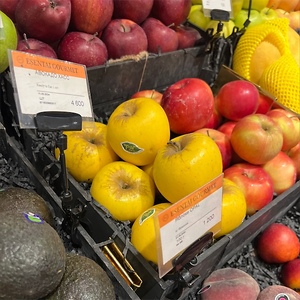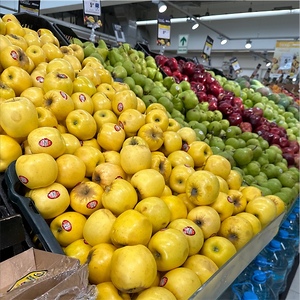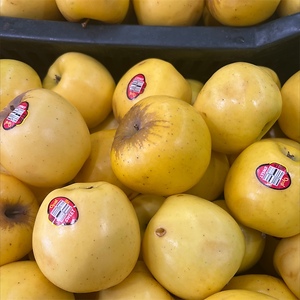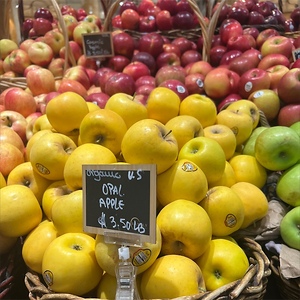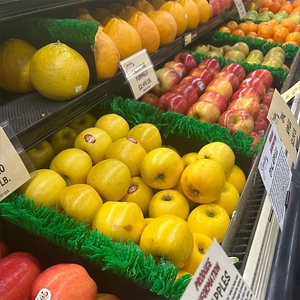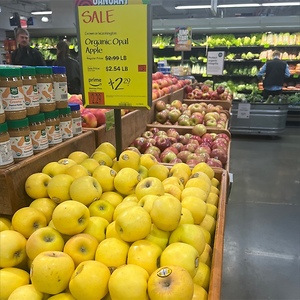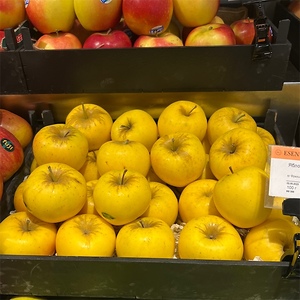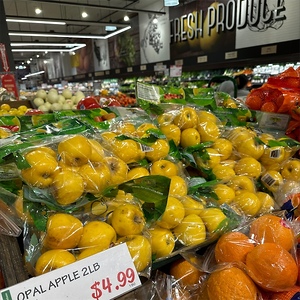

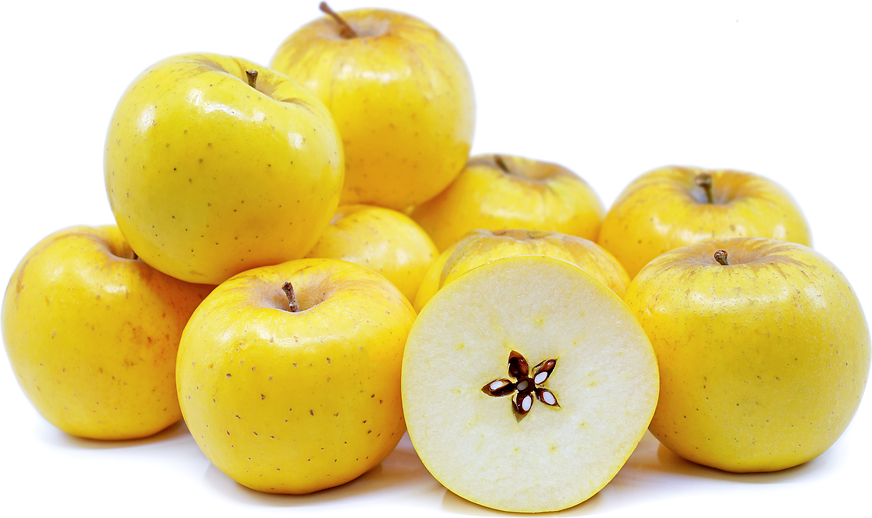
Opal® Apples
Estimated Inventory, lb : 0
Description/Taste
Opal® apples are a medium to large varietal, averaging 6 to 8 centimeters in diameter, and have a round to conical, relatively uniform appearance. The apples generally weigh between 10 to 14 ounces and showcase bright yellow skin, covered in tiny dark brown dots and light russeting around the stem cavity. The skin is semi-thick, glossy, and smooth, and underneath the taut surface, the flesh is white to ivory. Opal® apples have a fine-grained, aqueous, crisp, and prominently crunchy consistency. The apples release a faintly sweet, floral aroma and have moderate sugar and acidity levels, creating a balanced flavor profile. Opal® apples have a sweet, subtly tart, and tangy taste with pleasant fruity nuances reminiscent of banana, pear, and coconut.
Seasons/Availability
Opal® apples are available in the winter through spring.
Current Facts
Opal® apples, botanically classified as Malus domestica, are a late-season variety belonging to the Rosaceae family. The golden yellow apples were created in Europe in the late 20th century and were selected for commercial cultivation as a modern yellow apple cultivar, improving upon its parent variety, golden delicious. In American markets, Opal® apples are exclusively grown in Washington and are sold as a specialty variety available for a limited season. Consumers value Opal® apples for their unusual skin coloring, crunchy consistency, slow to brown nature, and sweet, subtly tangy flavor. The variety is versatile, treated as a dessert cultivar, consumed fresh, or it is also incorporated into sweet and savory cooked culinary preparations. Opal® apples are grown conventionally or organic and can be found through select retailers and distributors.
Nutritional Value
Opal® apples are a source of vitamin C to strengthen the immune system while reducing inflammation and copper to build connective tissues. The apples also provide calcium to build strong bones and teeth, potassium to balance fluid levels within the body, fiber to regulate the digestive tract, and other nutrients, including folate, vitamin K, and magnesium.
Applications
Opal® apples have a sweet, subtly tart flavor suited for fresh and cooked preparations. The apples are typically consumed straight out of hand and are savored for their crunchy, juicy flesh and balanced taste. Opal® apples are also popular for slicing and packing in on-the-go lunches, as the variety is slow to brown. This distinct trait allows the apples to stay crisp and white when served on cheese plates, shredded into slaws, or layered on top of open-faced bagel or toast spreads. Opal® apples can also be used in dips, chopped into salsa, incorporated as a crunchy element in appetizers, or combined into breakfast dishes such as overnight oats, Belgian waffles, or smoothies. In addition to fresh preparations, Opal® apples can be simmered into soups, cooked with roasted meats, or made into apple sauce. The sweet-tart nature of the flesh complements savory stuffing, vegetable medleys, and grains. The apples also add flavor and texture to sweet recipes, including muffins, cakes, pies, cobblers, and tarts. Beyond culinary preparations, Opal® apples can be pressed into juice and used to flavor carbonated beverages, fruit punches, and various cocktails and mocktails. Opal® apples pair well with cranberries, pomegranates, oranges, lemons, squash, cheeses such as goat, brie, and feta, herbs including thyme, dill, basil, and parsley, fennel, honey, spices such as cinnamon, cloves, and allspice, carrots, and red cabbage. Whole, unwashed Opal® apples will keep 1 to 3 months when stored in the refrigerator’s crisper drawer.
Ethnic/Cultural Info
Opal® apples are famous for their slow-browning flesh. Apples typically turn from white to brown once they are sliced open due to an enzyme known as polyphenol oxidase. The presence of oxygen triggers this enzyme, and exposing the freshly cut flesh to oxygen in the air causes polyphenol oxidase in the chloroplasts to undergo oxidative processes, transforming the coloring from white to brown. In Opal® apples, the flesh is naturally low in the enzyme, allowing it to remain white for extended periods. Several experiments have been conducted by bloggers and food writers, leaving sliced Opal® apples at room temperature and in the refrigerator to study this characteristic. Some of the studies left the apples out for six to eight hours, showing little to no signs of discoloration. It is important to note that Opal® apples acquired this trait through natural breeding processes and were not genetically modified. Opal® apples were actually one of the first apple varieties in the United States to be verified by the Non-GMO Project. This non-profit organization tests ingredients to inform consumers of non-genetically modified items.
Geography/History
Opal® apples are native to Europe and were developed in the Czech Republic in 1991. Apple breeder Dr. Jaroslav Tupy created the variety by crossing golden delicious and topaz apples at the Institute of Experimental Botany in Prague and spent more than a decade evaluating, trialing, and selecting apples. The variety’s name was initially UEB 32642 when it was introduced in 1999, and over time, it was rebranded to Opal® apples. After their release, Opal® apples were further studied in over 63 orchards across Europe and were introduced to the United States in 2010. Opal® apples are exclusively grown and marketed through FirstFruits Farm in Washington State, and the variety is protected under the US Plant Patent USPP 15963P2, active until 2024. The eastern Washington farm has over 6,000 acres of apple and cherry orchards and was once known as Broetje Orchards. Today Opal® apples are cultivated worldwide, including regions of Europe, the United States, Australia, New Zealand, South Africa, and South America.
Recipe Ideas
Recipes that include Opal® Apples. One



